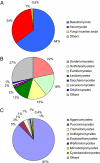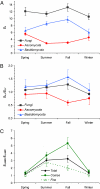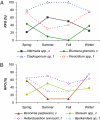High diversity of fungi in air particulate matter - PubMed (original) (raw)
High diversity of fungi in air particulate matter
Janine Fröhlich-Nowoisky et al. Proc Natl Acad Sci U S A. 2009.
Abstract
Fungal spores can account for large proportions of air particulate matter, and they may potentially influence the hydrological cycle and climate as nuclei for water droplets and ice crystals in clouds, fog, and precipitation. Moreover, some fungi are major pathogens and allergens. The diversity of airborne fungi is, however, not well-known. By DNA analysis we found pronounced differences in the relative abundance and seasonal cycles of various groups of fungi in coarse and fine particulate matter, with more plant pathogens in the coarse fraction and more human pathogens and allergens in the respirable fine particle fraction (<3 microm). Moreover, the ratio of Basidiomycota to Ascomycota was found to be much higher than previously assumed, which might also apply to the biosphere.
Conflict of interest statement
The authors declare no conflict of interest.
Figures
Fig. 1.
Species richness of airborne fungi: relative proportions of different phyla (A), different classes of Ascomycota (B), and different classes of Basidiomycota (C).
Fig. 2.
Seasonal variations in the species richness normalized by the number of investigated air samples (Sn) (A), the ratio of normalized species richness between coarse and fine particles (Sn,c/Sn,f) (B), and the ratio of normalized species richness between Basidiomycota and Ascomycota (Sn,BMC/Sn,AMC) (C). Error bars illustrate inter-sample variability (relative standard error of the arithmetic mean of the species richness of individual samples).
Fig. 3.
Seasonal variations in the relative frequency of occurrence (RFO) of selected species of Ascomycota (A) and Basidiomycota (B) in coarse and fine air particulate matter, respectively (c, f).
Similar articles
- Variations in abundance, diversity and community composition of airborne fungi in swine houses across seasons.
Kumari P, Woo C, Yamamoto N, Choi HL. Kumari P, et al. Sci Rep. 2016 Nov 28;6:37929. doi: 10.1038/srep37929. Sci Rep. 2016. PMID: 27892507 Free PMC article. - Detection and analysis of fine particulate matter and microbial aerosol in chicken houses in Shandong Province, China.
Yang W, Guo M, Liu G, Yu G, Wang P, Wang H, Chai T. Yang W, et al. Poult Sci. 2018 Mar 1;97(3):995-1005. doi: 10.3382/ps/pex388. Poult Sci. 2018. PMID: 29294119 - DNA analysis of outdoor air reveals a high degree of fungal diversity, temporal variability, and genera not seen by spore morphology.
Pashley CH, Fairs A, Free RC, Wardlaw AJ. Pashley CH, et al. Fungal Biol. 2012 Feb;116(2):214-24. doi: 10.1016/j.funbio.2011.11.004. Epub 2011 Nov 20. Fungal Biol. 2012. PMID: 22289767 - Fungal aerobiology: exposure and measurement.
Levetin E, Horner WE. Levetin E, et al. Chem Immunol. 2002;81:10-27. doi: 10.1159/000058872. Chem Immunol. 2002. PMID: 12101998 Review. No abstract available. - [Detection of fungi in the air by culture since 1940].
Ackermann HW. Ackermann HW. Rev Can Biol. 1968 Mar;27(1):61-8. Rev Can Biol. 1968. PMID: 4883801 Review. French. No abstract available.
Cited by
- Fungicide effects on fungal community composition in the wheat phyllosphere.
Karlsson I, Friberg H, Steinberg C, Persson P. Karlsson I, et al. PLoS One. 2014 Nov 4;9(11):e111786. doi: 10.1371/journal.pone.0111786. eCollection 2014. PLoS One. 2014. PMID: 25369054 Free PMC article. - Upper respiratory tract mycobiome alterations in different kinds of pulmonary disease.
Xu X, Ding F, Hu X, Yang F, Zhang T, Dong J, Xue Y, Liu T, Wang J, Jin Q. Xu X, et al. Front Microbiol. 2023 Mar 23;14:1117779. doi: 10.3389/fmicb.2023.1117779. eCollection 2023. Front Microbiol. 2023. PMID: 37032908 Free PMC article. - Terrestrial Macrofungal Diversity from the Tropical Dry Evergreen Biome of Southern India and Its Potential Role in Aerobiology.
Priyamvada H, Akila M, Singh RK, Ravikrishna R, Verma RS, Philip L, Marathe RR, Sahu LK, Sudheer KP, Gunthe SS. Priyamvada H, et al. PLoS One. 2017 Jan 10;12(1):e0169333. doi: 10.1371/journal.pone.0169333. eCollection 2017. PLoS One. 2017. PMID: 28072853 Free PMC article. - Seasonal variation of the dominant allergenic fungal aerosols - One year study from southern Indian region.
Priyamvada H, Singh RK, Akila M, Ravikrishna R, Verma RS, Gunthe SS. Priyamvada H, et al. Sci Rep. 2017 Sep 11;7(1):11171. doi: 10.1038/s41598-017-11727-7. Sci Rep. 2017. PMID: 28894264 Free PMC article. - Assessment of fungal diversity in a water-damaged office building.
Green BJ, Lemons AR, Park Y, Cox-Ganser JM, Park JH. Green BJ, et al. J Occup Environ Hyg. 2017 Apr;14(4):285-293. doi: 10.1080/15459624.2016.1252044. J Occup Environ Hyg. 2017. PMID: 27786737 Free PMC article.
References
- Elbert W, Taylor PE, Andreae MO, Pöschl U. Contribution of fungi to primary biogenic aerosols in the atmosphere: Wet and dry discharged spores, carbohydrates, and inorganic ions. Atmos Chem Phys. 2007;7:4569–4588.
- Bauer H, et al. Significant contributions of fungal spores to the organic carbon and to the aerosol mass balance of the urban atmospheric aerosol. Atmos Environ. 2008;42:588–593.
- Womiloju TO, Miller JD, Mayer PM, Brook JR. Methods to determine the biological composition of particulate matter collected from outdoor air. Atmos Environ. 2003;37:4335–4344.
- Held A, et al. Aerosol size distributions measured in urban, rural and high-alpine air with an electrical low pressure impactor (ELPI) Atmos Environ. 2008;42:8502–8512.
- Hock N, et al. Rural continental aerosol properties and processes observed during the Hohenpeissenberg Aerosol Characterization Experiment (HAZE2002) Atmos Chem Phys. 2008;8:603–623.
Publication types
MeSH terms
Substances
LinkOut - more resources
Full Text Sources
Medical
Molecular Biology Databases


